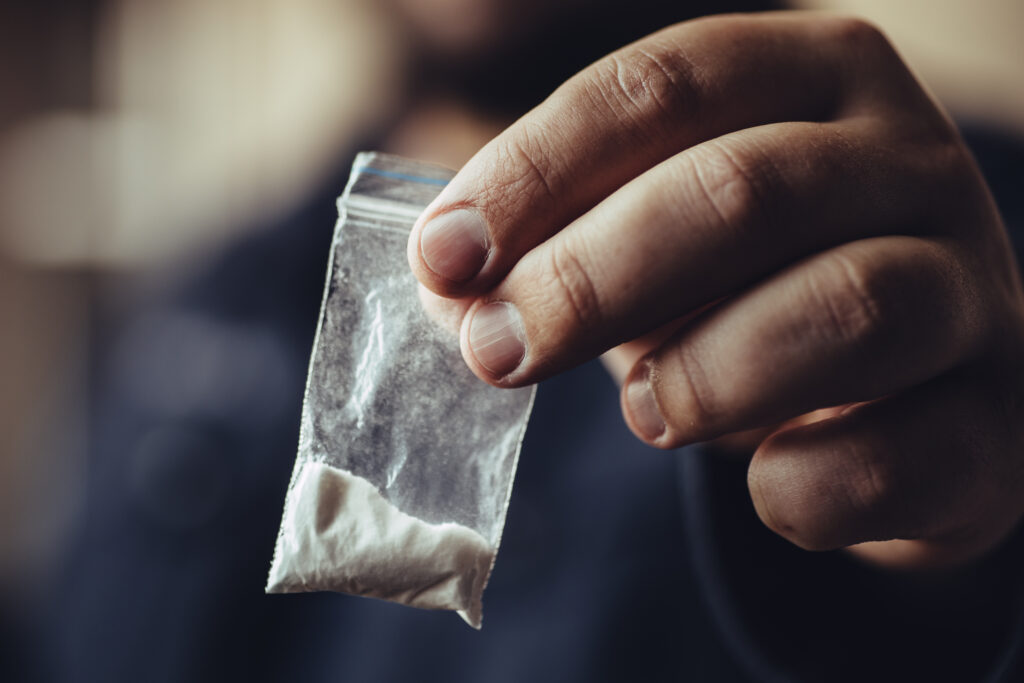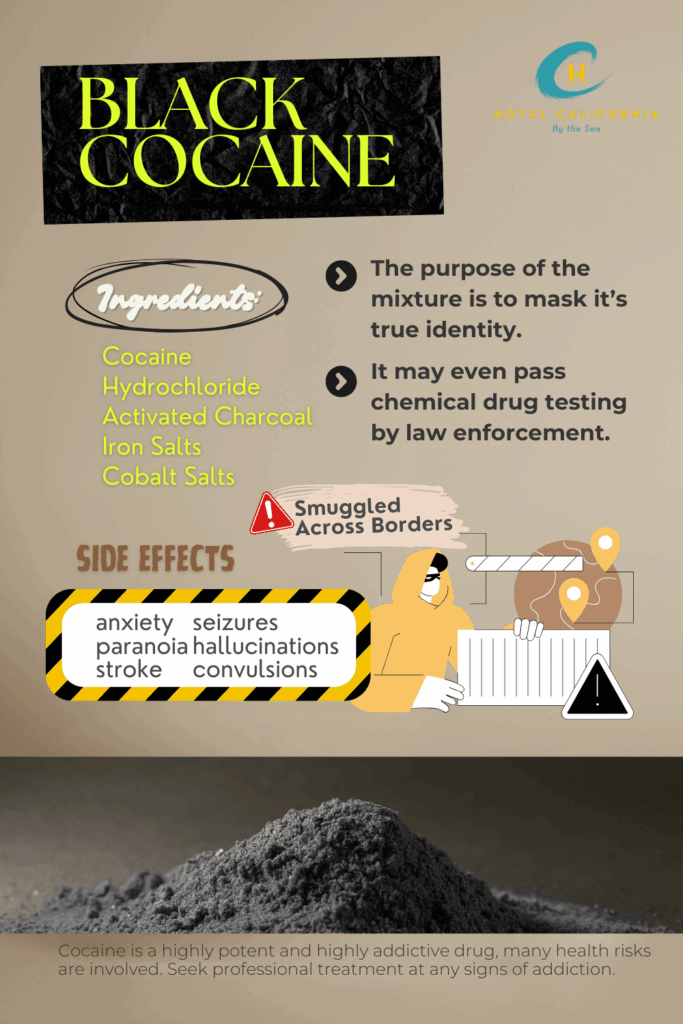What is Black Cocaine?
Black cocaine was created as a way to prevent the detection of the addictive stimulant drug. Cocaine is one of the most addictive central nervous system stimulant drugs. There are many different types of cocaine. The drug is often mixed in with different chemicals that produce new forms of the drug and result in a variety of colors, textures and purity.

Cocaine is often cut with many different types of dilutants such as baking soda, talcum powder, flour and sometimes even other drugs such as opioids. Black cocaine is just one of the many variations of cocaine mixtures that have hit the illicit drug market. However, black cocaine is a little different compared to other forms of the stimulant drug.
What is Black Cocaine?
Black cocaine or coca negra is a type of cocaine created to illegally smuggle the substance across borders without detection. It is not intended for actual drug use.
Black cocaine is a mixture of cocaine, hydrochloride, activated charcoal or carbon, iron salts, cobalt salts and other substances specifically used to hide the characteristics of cocaine. This is what gives the black appearance to the drug. Some of these added ingredients provide an altered appearance of the drug as well as the ability to pass chemical drug testing.
The purpose of creating this mixture is to keep the drug from being detectable to the naked eye. Black cocaine is a result of the drug trafficking industry increasing its efforts to avoid drug detection and being caught by law enforcement.

An estimated 90% of cocaine comes from Colombia, along with most of the black market cocaine. In order to avoid drug detection, drug traffickers began creating black cocaine as a discreet way to move the drugs through the US and countries in Europe. Black cocaine has been hidden as metal moldings, asphalt, fertilizer and even black printer toner.
Once the black cocaine reaches its destination, it is treated chemically to extract the cocaine from the mixture. Known as extraction, the mixture is subjected to chemical solvents to separate the base cocaine from other additives. The additional process the cocaine must go through will alter its purity, color and chemical structure.
History of Black Cocaine
There is really no documented history of the drug. It was said to have been invented in the mid-1980s by the Chilean dictator Augusto Pinochet. He ordered that a lab in Chile create black cocaine so that it could easily be smuggled into the US and Europe. Since then, drug traffickers have begun using this technique to help move cocaine and other drugs across borders more easily and avoid detection.
Recently, there have been several seizures of black cocaine around the world. They have been found hidden in religious icons, hidden in hammocks and hidden in a variety of other products. Drug traffickers have utilized this tactic and have altered cocaine in order to avoid detection.
Check Your Insurance Coverage for FREE
Find out if your insurance covers addiction treatment in minutes. We accept most insurance!
Types of Cocaine
- Cocaine or coca paste. Cocaine paste is the end result of the initial processing of the drug. It is the purest form of cocaine with a light grey color. It can be up to 90% pure cocaine.
- White powder cocaine. This type of cocaine is the most internationally recognized version of the drug. It is heavily diluted with other substances and cutting agents. It can be an off white color with a pinkish or light blue hue.
- Crack cocaine. Crack is the second most widely recognized form of cocaine. It is also the second most abused form of the drug. It is produced by removing the salt content through heat. It results in hard, yellowish rocks intended for smoking. Crack cocaine is much cheaper compared to other forms of the drug and it is very potent, producing an almost instant, powerful but short-lived high.
- Synthetic cocaine. These types of manufactured cocaine are often marketed as research chemicals and sold as designer drugs. RTI-126 is a popular compound of cocaine that is five times more potent than cocaine. Synthetic mixtures usually contain harmful chemicals such as bath salts.
- Pink cocaine. Pink cocaine is a synthetic compound also known as 2C-B or tusi. It is a bright pink powder that is usually snorted. It provides the stimulant effects of cocaine as well as the hallucinogenic effects of MDMA. It was made famous after it was found in the system of singer Liam Payne after his death.
- Trash cocaine. Trash cocaine is created from the byproducts of the initial cocaine production process. It is also made from other substances such as kerosene, ethanol and crude coca left over from the cocaine processing. In some cases, trash cocaine was found to have contained brick dust, ash, sulfuric acid and even the remains of human bones. The high from trash cocaine is extremely potent and addictive, despite its short-lived nature. It is the cheapest form of cocaine and the most addictive.
- Fish scale cocaine. This type of cocaine is also referred to as Peruvian or Bolivian flake. It is high-quality cocaine. In some cases, it is pure cocaine. The name fish scale comes from its appearance looking like tiny scales. This type of cocaine produces a gradual high with fewer residual side effects, which is often common in powder cocaine. It is a highly sought-after drug. It typically contains anywhere from 75% to 90% pure cocaine and is much stronger than street drugs. There is a higher risk of overdose with this form of cocaine due to its high potency.
- Yellow cocaine. This type of cocaine is off white with a yellowish tint. This is due to the drug impurities. It is a powdered form and heavily cut with substances such as household items. It is a very dangerous form of cocaine.
- Brown cocaine. This type of cocaine is a combination of pure cocaine and smokeless gunpowder. The gunpowder contains an ingredient called nitroglycerin. When nitroglycerin is ingested, it causes vasodilation, which allows the blood to move faster in the system. This allows the effects of cocaine to be more intense. It is a form of the drug that is rarely found outside of the continent of Africa. Brown cocaine has a history of being used on child soldiers.
The dangers and side effects of Cocaine
Some of the most common side effects of cocaine abuse include chest pain, strain on the heart, high blood pressure and risk of stroke. It can also cause symptoms of anxiety and paranoia. When snorting cocaine, the drug can cause damage to the nasal septum, sinus infections and constant nosebleeds and runny noses.
Users can experience seizures, hallucinations, convulsions, and even risk of bacterial infections. When injecting cocaine, users are at a high risk for HIV exposure, hepatitis infections, and the risk of overdose and death.
Reach out to Hotel California by the Sea
We specialize in treating addiction and other co-occurring disorders, such as PTSD. Our Admissions specialists are available to walk you through the best options for treating your addiction.
Treatment for Cocaine Addiction
Cocaine is a highly potent and highly addictive drug. The stimulant drug affects the central nervous system and can easily lead to addiction. Professional behavioral health treatment programs such as Hotel California by the Sea assist with cocaine use disorder.
We offer treatment at all levels of care, including detox, residential, PHP and IOP. We utilize evidence-based treatment methods such as CBT, DBT and family therapy. Hotel California by the Sea is dedicated to helping clients reach their goals in sobriety and overcome their addiction.
References:
https://recovered.org/stimulants/cocaine/types-of-cocaine
https://www.tbsnews.net/bangladesh/crime/what-black-cocaine-785578
https://www.dea.gov/sites/default/files/pr/microgram-journals/2013/mj10-1_8-11.pdf
https://bedrockrecoverycenter.com/addiction/cocaine/types/black/
https://www.hazeldenbettyford.org/addiction/cocaine-symptoms
https://wellbrookrecovery.com/blog/types-of-cocaine/
